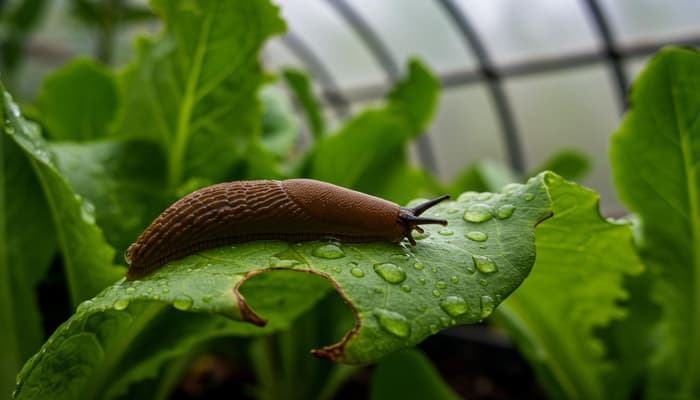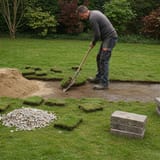The Ultimate Guide to Slug Control
Key Takeaways
- Understanding Slugs: Not all slugs are villains ? some actually benefit your garden ecosystem.
- Prevention Methods: Morning watering slashes slug damage as effectively as chemical pellets.
- Natural Barriers: Copper, seaweed, and bran create impassable defensive zones.
- Organic Control Methods: Beer traps, hand-picking, and natural predators form your slug-fighting arsenal.
- Plant Selection: Choose naturally resistant plants and stop fighting a losing battle.
- What To Avoid: Stop wasting time on methods science proves don't work.
- Quick Emergency Fixes: Rescue plants under immediate siege.
- Seasonal Action Plan: Stay one step ahead with targeted seasonal interventions.
- FAQs: Straight answers to your most pressing slug questions.
Slugs devour gardens under cover of darkness. You need battle-tested solutions, not garden myths.

This guide cuts through the noise with research-backed methods that actually work. No more wasted time on ineffective "hacks" ? just proven strategies for keeping your plants intact and your garden thriving.
Understanding Slugs
Slugs operate like nocturnal commandos, striking when conditions favour them ? warm, damp nights when garden defences are lowest. They leave behind slime trails and devastation.
When Slugs Are Most Active
- Spring: Peak destruction coincides with tender new growth.
- Night-time: Most feeding occurs under darkness.
- After Rain: Wet conditions create slug superhighways between plants.
Good Slugs vs. Bad Slugs
Not all slugs deserve elimination. The Green Cellar and Leopard slugs actually help your garden by consuming fungi and decaying matter. Your enemies are the common brown field slugs that target living plants.

Prevention Methods
Prevention demolishes slug problems before they start. These strategies create hostile conditions that slugs actively avoid.
Water in the Morning
Research proves morning watering equals the effectiveness of chemical pellets. This simple schedule shift allows soil to dry by evening, eliminating the damp pathways slugs need to travel between plants.
Use Dry Mulch
Straw-based mulch creates a defensive perimeter that reduces slug damage by 20%. Added bonus: it simultaneously improves soil health.
Keep Garden Tidy
Eliminate slug sanctuaries. Remove fallen leaves, excess debris, and hiding spots where slugs shelter during daylight hours.
Plant Protection for Seedlings
Transform plastic bottles into mini-greenhouses over vulnerable seedlings. This physical barrier blocks access during the most vulnerable growth phase.
Start Seedlings Indoors
Grow seedlings to 10cm height before outdoor transplanting. Mature plants withstand slug attacks that would obliterate younger ones.

Natural Barriers
These barriers trigger slug aversions and create defensive perimeters they won't cross.
Copper Solutions
How it works: Copper delivers a mild electrical shock to slugs' sensitive bodies, forcing retreat.
Best applications:
- Wrap genuine, thick copper tape around pots.
- Install copper rings around vulnerable plants (bury them deep).
Effectiveness: (Highly effective when properly installed)
Seaweed Meal/Dust
How it works: Natural minerals and salt content create a barrier slugs refuse to cross.
Best applications:
- Create a perimeter around entire garden beds.
- Form protective circles around individual seedlings (keep away from stems).
Effectiveness: (Excellent protection plus soil enrichment)
Coffee Grounds
How it works: Caffeine toxicity plus abrasive texture deters slug movement.
Best applications:
- Distribute around plant bases.
- Mix with compost before planting.
Effectiveness: (Works best when refreshed after rain)
Bran Barrier
How it works: Slugs gorge on bran, become bloated and dehydrated, making them easy prey for birds.
Best applications:
- Create rings around plants (keep away from stems).
Effectiveness: (Top performer in Gardeners' World trials)
Greasy Barriers
How it works: Prevents slugs from adhering to surfaces, blocking their climbing ability.
Best applications:
- Apply Vaseline or WD-40 around pot rims.
- Install double-sided tape on pot edges.
Effectiveness: (Strong anecdotal evidence supports effectiveness)

Organic Control Methods
When barriers aren't enough, deploy these active countermeasures.
Beer Traps
Requirements: Shallow containers and cheap beer.
Deployment protocol:
- Bury containers with rim 1cm above soil.
- Half-fill with beer.
- Position at bed perimeters near vulnerable plants.
- Empty and refresh regularly.
Effectiveness: (Attracts and eliminates slugs but may not significantly reduce plant damage)
Manual Removal
Requirements: Torch, gloves, container of salt water or boiling water.
Deployment protocol:
- Patrol 2 hours after dusk with torch.
- Collect slugs from plants and soil.
- Deposit in collection container.
- Relocate at least 20m away or add to compost heap.
Effectiveness: (Highly effective but labour-intensive)
Biological Controls
Requirements: Nematodes (Phasmarhabditis hermaphrodita).
Deployment protocol:
- Apply to soil when temperature exceeds 5?C.
- Water in during evenings when soil is moist.
- Reapply every six weeks throughout growing season.
Effectiveness: (Excellent results but higher cost)
Encourage Natural Predators
Strategic partnerships:
- Install bird feeders and baths (thrushes are professional slug hunters).
- Create wildlife ponds for frogs and toads.
- Establish log piles for beetles and hedgehogs.
- Consider ducks for serious infestations.
Effectiveness: (Sustainable long-term solution)
Plants That Resist Slugs
Stop fighting unwinnable battles. These plants naturally repel slugs through scent, texture, or chemical composition.
Slug-Resistant Flowers
- Lavender
- Foxgloves (toxic to slugs)
- Geraniums
- Phlox
- Ferns
- Euphorbia
- Scabious
- Billy Buttons
- Lamb's ears
- Astrantia
Slug-Resistant Vegetables & Herbs
- Rosemary
- Chives
- Garlic
- Mint
- Fennel
- Sage
- Onions
Vulnerable Plants Requiring Extra Protection
- Hostas (except resistant varieties like 'Blue Mouse Ears')
- Delphiniums
- Dahlias
- Sweet peas
- Lettuce and salad greens
- Strawberries
What To Avoid
Stop wasting time on these debunked methods.
Ineffective Methods
- Eggshells: RHS studies confirm slugs easily glide over eggshell barriers.
- Salt directly on soil: Damages plants and destroys soil structure.
- Diatomaceous earth: Ineffective in UK's damp climate.
- Regular slug pellets: Collateral damage to beneficial wildlife and pets.
Quick Emergency Fixes
When plants face immediate threat, deploy these rapid-response measures.
1. Copper Tape Emergency
Wrap container plants with copper tape (clean with vinegar first for maximum effectiveness).
2. Coffee Spray Shield
Mix strong coffee with water (1:1 ratio) and apply around plants (never directly on them).
3. Midnight Patrol
Conduct night collection with torch to save plants under active attack.
4. Protective Mini-Greenhouse
Convert plastic bottles into protective shields over valuable seedlings.
Seasonal Action Plan
Spring (March-May)
- Start seedlings in greenhouses.
- Destroy slug eggs when turning soil.
- Apply nematodes when soil temperature reaches 5?C.
- Deploy beer traps strategically.
- Install copper barriers on containers.
Summer (June-August)
- Implement strict morning-only watering.
- Maintain beer trap network.
- Continue night patrols during wet periods.
- Renew barriers after heavy rain.
- Protect vulnerable seedlings in cold frames.
Autumn (September-November)
- Remove fallen leaves and plant debris promptly.
- Inspect pot undersides and garden furniture for slugs.
- Expose eggs to predators by turning soil.
- Apply autumn nematode treatment.
- Consider raised beds for vulnerable crops.
Winter (December-February)
- Plan slug-resistant planting strategy.
- Prepare your potting shed for early spring seedlings.
- Check stored bulbs for slug damage.
- Construct wildlife habitats for natural predators.
Effectiveness Chart
| Method | Effectiveness | Ease of Use | Cost | Environmental Impact |
|---|---|---|---|---|
| Morning Watering | Free | None | ||
| Copper Barriers | Medium | Low | ||
| Beer Traps | Low | Low | ||
| Hand Picking | Free | None | ||
| Seaweed Meal | Low | Beneficial | ||
| Bran Barrier | Low | None | ||
| Coffee Grounds | Low/Free | Low | ||
| Nematodes | High | Low | ||
| Eggshells | Free | None | ||
| Resistant Plants | Varies | Beneficial |
Frequently Asked Questions
-
What do slugs hate most?
Slugs detest dryness, copper, caffeine, and aromatic plant compounds. They avoid sharp, dry, or greasy surfaces unless lured by an irresistible plant.
-
Does vinegar kill slugs?
Vinegar instantly kills slugs on contact. Mix equal parts water and vinegar in a spray bottle and apply directly to slugs ? never on plants, as the acidity damages vegetation.
-
What is the best natural slug control?
The most effective approach combines multiple strategies: morning watering, seaweed meal barriers, predator encouragement, and resistant plants. No single method delivers complete protection.
-
How to get rid of slugs permanently?
Complete elimination isn't realistic. Focus instead on population management through habitat modification (morning watering, garden tidiness), physical barriers, natural predators, and strategic plant selection.
-
What is the best way to control slugs in the UK climate?
The UK's damp conditions demand a multi-layered defence: morning watering, seaweed barriers, copper protection for containers, and bird/hedgehog encouragement. Beer traps and nematodes thrive in British conditions.
-
Do coffee grounds really work against slugs?
Coffee grounds deter slugs through caffeine toxicity and abrasive texture. Effectiveness demands fresh grounds applied in thick layers. Reapplication after rain is essential.
-
Are slug pellets safe to use?
Metaldehyde pellets destroy beneficial wildlife alongside slugs. Organic iron phosphate pellets offer safer alternatives but should be used sparingly as they still impact beneficial organisms at high concentrations.
-
How do I protect my hostas from slugs?
Defend hostas with deep-buried copper rings, seaweed meal barriers, container growing with copper tape, or select resistant varieties like 'Blue Mouse Ears' and 'Frances Williams'.
-
Can I use salt to kill slugs?
Salt kills slugs effectively but damages soil structure and harms plants. Reserve salt water for containers of collected slugs rather than direct garden application.
-
Will making my garden wildlife-friendly help control slugs?
Absolutely. Birds, hedgehogs, frogs, toads, and ground beetles naturally regulate slug populations. Creating habitat for these allies (feeders, ponds, log piles) establishes sustainable, long-term control.
Reality check: Perfect slug elimination isn't possible or even desirable for a healthy ecosystem. Success means reducing damage to acceptable levels while maintaining garden biodiversity.


